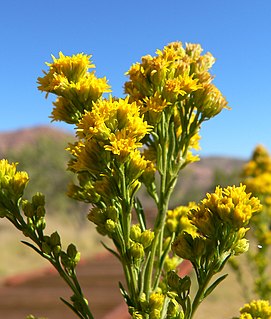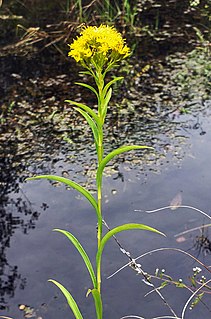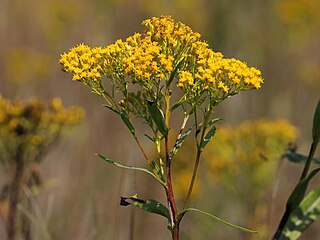
Solidago, commonly called goldenrods, is a genus of about 100 to 120 species of flowering plants in the family Asteraceae. Most are herbaceous perennial species found in open areas such as meadows, prairies, and savannas. They are mostly native to North America, including Mexico; a few species are native to South America and Eurasia. Some American species have also been introduced into Europe and other parts of the world.

Goldenrod is a common name for many species of flowering plants in the sunflower family, Asteraceae, commonly in reference to the genus Solidago.

Solidago flexicaulis, the broadleaved goldenrod, or zigzag goldenrod, is a North American species of herbaceous perennial plants in the family Asteraceae. It is native to the eastern and central parts of the United States and Canada, from Nova Scotia west to Ontario and the Dakotas, and south as far as Alabama and Louisiana. It grows in a variety of habitats including mesic upland forests, well drained floodplain forests, seepage swamp hummocks, and rocky woodlands.

Solidago caesia, commonly named blue-stemmed goldenrod, wreath goldenrod, or woodland goldenrod, is a flowering plant native to North America.

Solidago nemoralis is a species of flowering plant in the family Asteraceae. It is native to North America, where it is widely found in Canada and the United States. Its common names include gray goldenrod, gray-stem goldenrod, old-field goldenrod, field goldenrod, prairie goldenrod, dwarf goldenrod, and dyersweed goldenrod.

Solidago spectabilis is a species of goldenrod known by the common names Nevada goldenrod, basin goldenrod, and showy goldenrod. It is native to the western United States in the Great Basin and surrounding areas. It is found in California, Arizona, Nevada, Oregon, and Utah. There are historical records saying it once grew in southwestern Idaho, but is now extirpated there. This variety has also been seen in the western Montana county of Sanders.

Solidago houghtonii is a rare North American species of flowering plant in the family Asteraceae known as Houghton's goldenrod. It is native to southern Ontario, Canada and the northern United States. It is threatened by the loss and degradation of its habitat. It is a federally listed threatened species of the United States and it is designated a species of special concern by Canada's Committee on the Status of Endangered Wildlife in Canada.

Solidago missouriensis is a species of flowering plant in the family Asteraceae known by the common names Missouri goldenrod and prairie goldenrod. It is native to North America, where it is widespread across much of Canada, the United States, and northern Mexico. It grows from British Columbia east to Manitoba, south as far as Sonora, Coahuila, Texas, and Mississippi.

Solidago odora, the sweet goldenrod, anisescented goldenrod or fragrant goldenrod, is a North American species of goldenrod within the family Asteraceae. The plant is native to the United States and Mexico, found in every coastal state from Veracruz to New Hampshire and as far inland as Ohio, Missouri, and Oklahoma. It flowers from July through October.

Solidago buckleyi, or Buckley's goldenrod, is a species of goldenrod native to central North America. It is an uncommon species with a small range, being found mainly in the Ozark Mountains of Arkansas and Missouri, and in the uplands near the confluence of the Ohio and Mississippi Rivers near southern Illinois and western Kentucky. There are also a few isolated populations reported from Indiana. Its preferred habitat is open oak woodlands.

Solidago velutina, the threenerve goldenrod or velvety goldenrod, is a plant species native to Mexico and to the western United States. The species has been found in southwestern Oregon, east to the Black Hills of South Dakota, and as far south as México State in the central part of the Republic of México. It is classified as a member of Subsection Nemorales.

Solidago ptarmicoides, the prairie goldenrod, white flat-top goldenrod or upland white aster, is a North American perennial flowering plant in the family Asteraceae. It is native to the central and eastern Canada and parts of the United States (mostly Great Lakes region, the Northeast, the Ozarks, and the northern Great Plains, with isolated populations in Wyoming, Colorado, Oklahoma, and scattered locations in the Southeast. It has also been called upland white solidago, upland white goldenrod, and sneezewort goldenrod
Solidago ludoviciana, the Louisiana goldenrod, is a North American plant species in the family Asteraceae native to Louisiana, Texas and Arkansas. It can be found in dry open woods and along roadsides and other sunny, disturbed locations.

Solidago petiolaris is a North American species of goldenrod commonly called the downy ragged goldenrod. It is native to the United States and Mexico, in every coastal state from Texas to North Carolina, inland as far as southern Illinois, southern Nebraska, northeastern New Mexico, and Coahuila. Its preferred habitat is sandy areas.

Solidago gattingeri, common name Gattinger's goldenrod, is a species of plant that is a goldenrod. It is native only to the Ozark Mountains of Arkansas and Missouri and to the Nashville Basin of Tennessee. Its preferred habitat is cedar glades, cedar barrens, and limestone outcrops. It is adapted to dry habitats.

Solidago simplex, the Mt. Albert goldenrod or sticky goldenrod, is a North American plant species in the genus Solidago of the family Asteraceae. It is widespread across much of Canada, parts of the United States, and northeastern Mexico.

Solidago riddellii, known as Riddell's goldenrod, is a North American plant species in the genus Solidago of the family Asteraceae. It grows primarily in the Great Lakes and eastern Great Plains of Canada and the United States. It is sometimes considered part of the genus Oligoneuron, but as a Solidago, included in the section Solidago sect. Ptarmicoidei, the flat-topped goldenrods.
Solidago brachyphylla is a North American species of flowering plant in the family Asteraceae known by the common name Dixie goldenrod. It is native to the southeastern United States, from southern Mississippi to the Carolinas.

Solidago ulmifolia, commonly known as elmleaf goldenrod, is a North American species of goldenrod in the family Asteraceae. It is found in Canada and the eastern and central United States.

Solidago sect. Ptarmicoidei is a section of flowering plants in the genus Solidago. They are sometimes considered a separate genus: Oligoneuron. Like related species they are known as goldenrods. This section contains seven species of perennial herbs, all native to North America. They are distinguished from other goldenrods by their corymbiform flowerheads, which are flat or rounded in profile and about as broad as tall or broader, for which they are sometimes called flat-topped goldenrods.


















